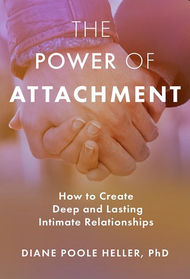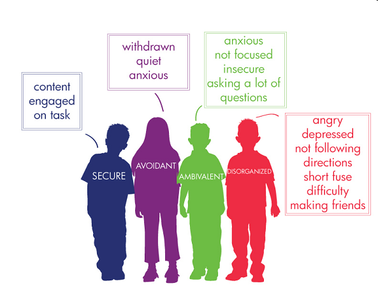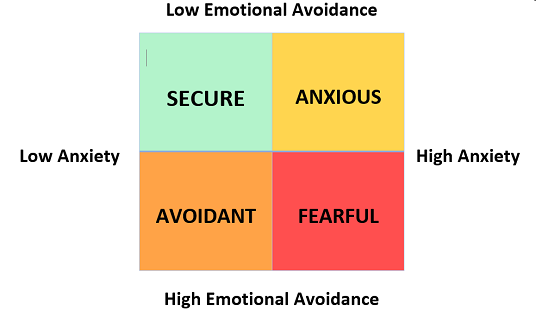Secure AttachmentSecure healthy attachment with parents who are consistent, attuned, present, and safe, offers the holding environment that allows for healthy relating and bonding. Fortunately, we can re-access the original, innate healthy attachment system later in life. When we come to understand our early attachment styles in a healthy environment today, the original imprints that are the foundation of our self-protective ego structure can be healed so that we can have more contact with our intrinsic core intactness and enjoy fulfilling relationships embodying our Authentic Self.
Ambivalent/Anxious Preoccupied AttachmentThe here today, gone tomorrow ‘anxious’ type of bonding leads to continual frustration and insecurity in relating, that may manifest as feeling incapable of ever being truly loved or lovable enough, and an over-focus on the “other” and an under-focus on the self.
We need to create enough consistent and reliable contact for an ambivalent person to relax the over-focus on others and to find and connect with themselves. They avoid distance with others, and fear abandonment. They seek closeness, but struggle with the fear of losing it. They often underestimate themselves and their real capacities. This comes from the parenting style they received of an “on again/off again“ connection, and unreliable love. Their was no consistency. They may feel unloved and/or unlovable, due to the dynamics of the past, and project the unavailability and lack of fulfillment on current partners. Sometimes in adult relationships, the person reverses the pattern and becomes the unavailable one. |
Avoidant AttachmentUnavailability, hostility, and lack of fulfillment from caregivers in the ‘Avoidant’ attachment model can result in a feeling that relationship and intimacy are so difficult that we tend to stay on the sidelines…perhaps a major ‘disconnection’ from relationships is a source of comfort in life. Parents may have been distant emotionally, and rejecting and insensitive to child’s needs.
We need to create enough safety and presence for an avoidant person to risk reaching out again in adult relationships after the intolerable frustration, hurt, and unavailability they experienced as children. What happens when the other person they meet has the capacity to be present and safe enough for potential bonding to occur? We must honor that to not feel, and to dismiss others, was the strategy that helped them survive childhood. Disorganized AttachmentWhen a parent is terrifying, we may become so frightened and confused in relating, that ‘Disorganized’ attachment can result. This describes a conflict between two major biological drives that occurs when a child looks for a safe attachment figure, and finds instead a need to protect one’s self through the survival instincts to dis-attach.
Read more about attachment styles... Take an attachment style test... |
|
|
|
BOOKS

In The Power of Attachment, Dr. Diane Poole Heller, a pioneer in attachment theory and trauma resolution, shows how overwhelming experiences can disrupt our most important connections— with the parts of ourselves within, with the physical world around us, and with others.
“We are fundamentally designed to heal. Even if our childhood is less than ideal, our secure attachment system is biologically programmed in us, and our job is to simply find out what’s interfering with it—and learn what we can do to make those secure tendencies more dominant.” Diane Poole Heller
Check out this helpful Attachment Styles "Cheat Sheet"
“We are fundamentally designed to heal. Even if our childhood is less than ideal, our secure attachment system is biologically programmed in us, and our job is to simply find out what’s interfering with it—and learn what we can do to make those secure tendencies more dominant.” Diane Poole Heller
Check out this helpful Attachment Styles "Cheat Sheet"
It Won’t Hurt Forever. Recognizing, responding to and preventing childhood trauma. Peter Levine and Maggie Kline
The General Theory of Love by T. Lewis, F. Amini, & R. Lannon
Facilitating Developmental Attachment: The Road to Emotional Recovery and Behavioral Change in Foster and Adopted Children by Hughes, Daniel A., Jason Aronson, Inc.
Becoming Attached: First Relationships and How They Shape Our Capacity to Love by Robert Karen, Ph.D
The Neurobehavioral and Social-Emotional Development of Infants and Children by Ed Tronick
Attachment in Psychotherapy by David J. Wallin
What Babies Want, A Documentary by Debby Takikawa DVD
Hold Me Tight by Sue Johnson
The Developing Mind, and Parenting from the Inside Out by Dan Siegel, M.D
Growing Up Again by J. Illsley Clarke and C. Dawson
The General Theory of Love by T. Lewis, F. Amini, & R. Lannon
Facilitating Developmental Attachment: The Road to Emotional Recovery and Behavioral Change in Foster and Adopted Children by Hughes, Daniel A., Jason Aronson, Inc.
Becoming Attached: First Relationships and How They Shape Our Capacity to Love by Robert Karen, Ph.D
The Neurobehavioral and Social-Emotional Development of Infants and Children by Ed Tronick
Attachment in Psychotherapy by David J. Wallin
What Babies Want, A Documentary by Debby Takikawa DVD
Hold Me Tight by Sue Johnson
The Developing Mind, and Parenting from the Inside Out by Dan Siegel, M.D
Growing Up Again by J. Illsley Clarke and C. Dawson

